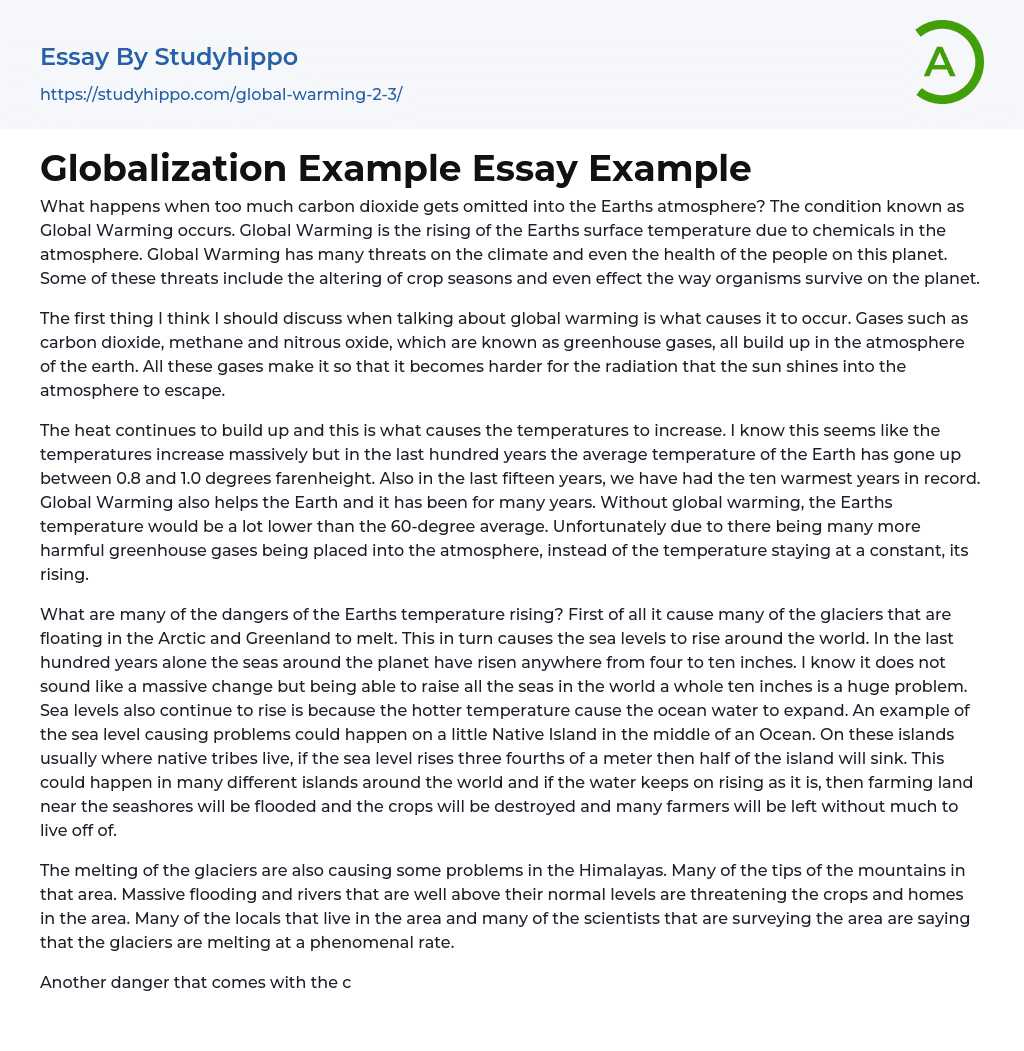Global Warming is caused by excessive carbon dioxide emissions in the Earth's atmosphere, resulting in an increase in the planet's surface temperature due to atmospheric chemicals. This phenomenon has diverse consequences, including changes in crop seasons and endangerment of organisms. These effects have adverse impacts on both climate and human well-being.
The main cause of global warming is the accumulation of greenhouse gases in the earth's atmosphere, such as carbon dioxide, methane, and nitrous oxide. These gases create a barrier that traps the sun's radiation.
Despite a rise in temperature of only approximately 0.8 to 1.0 degrees Fahrenheit over the last century, the Earth's average temperature has remained above 60 degrees due to the beneficial effects of global warming. However, excessive emission of harmful gre
...enhouse gases has disrupted this stability and caused a continuous increase in temperature. This is evident from the fact that the ten warmest years on record have all occurred within the past fifteen years.
The Earth's rising temperature is causing the glaciers in the Arctic and Greenland to melt, which is a major concern. This melting leads to an increase in global sea levels, which have risen between four to ten inches over the past century. The rise in sea levels creates significant problems because hotter temperatures cause ocean water expansion. The consequences of this rise are severe and include islands sinking in oceans. For example, if the sea level increases by three-fourths of a meter, half of an island populated by native tribes could submerge. This possibility exists for numerous islands around the world. If the water continues to rise, farmland near coastlines will be
flooded, resulting in crop destruction and leaving many farmers without a sustainable livelihood.
The melting glaciers in the Himalayas are causing various issues, such as impacting mountain peaks and leading to extensive flooding and higher river levels. Consequently, crops and homes in the vicinity are in danger. Local residents and scientists conducting surveys in the area are deeply concerned about the alarming speed at which these glaciers are melting.
Climate change presents a possible danger by promoting greater evaporation in hotter climates, which subsequently results in increased precipitation in areas unaccustomed to heavy rainfall. Consequently, the elevated sea level rise can also be attributed to the augmented amount of rainfall.
Global warming poses a threat to the environment and human health, particularly among vulnerable populations like the elderly. The increased heat caused by global warming significantly impacts these individuals, leading to more cases of heat-related illnesses such as heat stroke and exhaustion. Furthermore, higher temperatures contribute to disease spread by creating favorable conditions for disease-carrying mosquitoes and insects. An example of this occurred in New York, where an uncommon disease called St. Louis Encephalitis emerged due to stagnant water sources that mosquitoes used for drinking in hot weather. As a result, infected mosquitoes transmitted the disease to humans through bites, causing widespread panic throughout the New York Metropolitan area.
Both hot and cold regions are affected by Global Warming. This was demonstrated during a recent cold spell in the Midwest. Montana experienced temperatures dropping to minus 30 degrees for over three weeks, which have yet to return to normal conditions. Furthermore, blizzards struck the East Coast, causing certain areas of New
York State to receive more than twenty feet of snow.
Uncertainty looms over the future of Earth as some people dismiss global warming as a natural phenomenon. However, scientists warn that if this belief is mistaken, global temperatures could surge by five to nine degrees and sea levels may elevate by one to four feet before the middle of the 21st century.
When the temperature reaches a certain point, the polar ice caps will begin to melt. This may bring happiness to those living in the Arctic, but it will have serious effects worldwide. Even if only some of the polar ice caps melt, it will lead to a significant increase in sea levels, potentially completely submerging numerous coastal cities like San Francisco and New York. Cities not fully submerged by rising water levels will eventually experience unprecedented hurricanes. It is important to note that inland cities are also in danger; instead of rising seas and hurricanes, they will face drought.
To prevent the mentioned earlier consequences, it is crucial to decrease air pollution. Decreasing the burning of coal and fossil fuels can significantly lower greenhouse gas emissions and slow down global warming, although some amount of Carbon Dioxide will always be released into the atmosphere. United States Presidents' administrations have made multiple efforts to mitigate climate change. Although I may not witness significant changes during my lifetime, there is a possibility that future generations will be affected. Hopefully, they will not encounter severe repercussions.
- Animal Welfare essays
- Climate Change essays
- Conservation essays
- Global Warming essays
- Plastic essays
- Recycling essays
- Waste Management essays
- Zoo essays
- Atmosphere essays
- Biodiversity essays
- Coral Reef essays
- Desert essays
- Earth essays
- Ecosystem essays
- Forest essays
- Lake essays
- Natural Environment essays
- Ocean essays
- Oxygen essays
- Rainbow essays
- Sea essays
- Soil essays
- Volcano essays
- Water essays
- Wind essays
- Anthropology essays
- Audience essays
- Charity essays
- Cultural Competence essays
- Emile Durkheim essays
- Gender Roles essays
- Generation essays
- Globalization essays
- Interpersonal Relationship essays
- People essays
- Race essays
- Social Change essays
- Social Class essays
- Social Movement essays
- Social Science essays
- Social Status essays
- Social Stratification essays
- Society essays
- Sociological Imagination essays
- Sociological Perspective essays
- Sociological Theories essays
- Stereotypes essays
- Web Dubois essays




